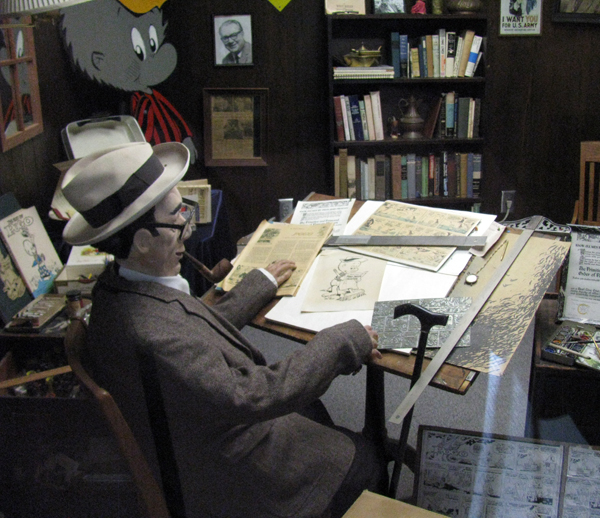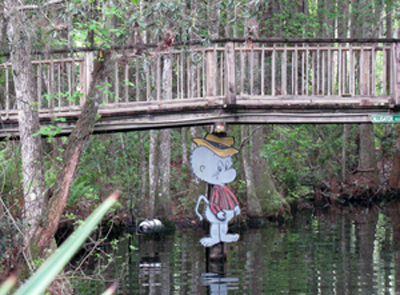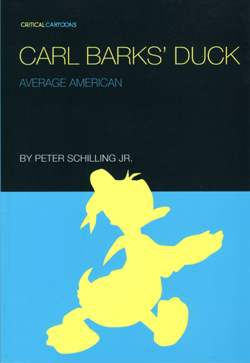
"What's New" Archives: April 2015
April 23, 2015:
A Funnybooks Roundup
April 18, 2015: On the Road with Kelly and Barks
April 23, 2015:
A Funnybooks Roundup
I'll be talking about the book and signing copies at the Arkansas Literary Festival on Saturday. My session will be 10 a.m. at the Central Arkansas Library's Cox Creative Center, 120 River Market Avenue in Little Rock's downtown River Market district. My interlocutor will be Randy Duncan, a professor at Henderson State University in Arkadelphia and co-author of The Power of Comics, the trailblazing introductory textbook for comic art studies courses.
Funnybooks has been nominated for an Eisner award, in the category "Best Scholarly/Academic Work." The "scholarly" fits, I think, and I'll be delighted if I win. If you're not familiar with the Eisners, here's a link to the most up-to-date information.
The book continues to attract some good reviews, including one earlier this month by Paul Gravett in the Times Literary Supplement of London. The TLS, probably the single most prestigious literary publication in English, has given each of my last three books respectful attention, and sometimes much better than that, as with Paul's very gratifying review. It's behind a TLS paywall, unfortunately, but he has published a fuller version on his website.
I have somehow managed not to mention until now Ron Wolfe's very enjoyable piece about me and the book in the Arkansas Democrat-Gazette, which piece is, happily and unexpectedly, not behind a paywall. Ron is a very good cartoonist himself—he draws as well as writes for the newspaper—and he once shared with me a letter he received from Carl Barks. In other words, his article is rooted in much greater knowledge of the comics, and sympathy for them, than is typical of such newspaper pieces.
From Chase Pritchard: I'm going to use your latest post to give myself the excuse to sing the praises of Funnybooks. I went into this book with a different perspective, since I wasn't part of the generation that read funny-animal comics when someone could say they were having a "golden age" (as of this writing, I'm in my early 20s). I did not even grow up reading Barks, Kelly, or Stanley, but thanks to the efforts of Thad Komorowski, Frank Young, yourself, and others, I've read enough of their material (since I was a teenager) to get a firm grip on the book's core message. The concise analysis was enough for me to understand why somebody should take these men seriously. Maybe even to get them to read them again! I always considered it a testament to the writer if they can make the subject matter captivating to those who might not have taken it seriously, and as with cartoons, you have now done the same with comics, to the point where, like in Hollywood Cartoons, I wish the book examined more figures. Maybe this can be the starting point for future research? And boy, all that financial information! I have no doubt that's going to benefit historians in the future.
P.S. I also read Furr and Purr yesterday, and I had a wonderful time reading that as well. It's really comforting to know that your fictional writing is just as intriguing as your historical tomes, and I hope you pursue that further. I already want another book on what Richard Rodgers is doing nowadays!
From Patrick Simpson: I wanted to let you know that I think your book Funnybooks is amazing. The research that must have been required to pull together such an eloquent and enlightening history of Dell and Western is staggering. Your passion for this material is evident on every page.
I have been an avid Dell and Gold Key comic collector for many years. Many other collectors have asked me: Why? I have always said that the simplicity of the story telling, the magic of the artwork, and the capture of times past has captured me like no other publisher. Now I can just tell them to buy your book! Thank you for sharing this with the world. It is a treasure.
[Posted April 28, 2015]
From B. Baker: Well, as it stands right now, the Arkansas Democrat-Gazette article by Ron Wolfe does indeed seem to behind a paywall. The link goes directly to a page that displays three of the photos that accompany the story, but instead of the text of the article, there is this message:
"This story is only available from the Arkansas Online archives. Stories can be purchased individually for $2.95. Click the link below to search for this story in the archives. If the search doesn't yield any results, contact the Arkansas Democrat-Gazette library at (501) 378-3851 with the section, date and page information below."
I did like the photo of your bookshelf, and the picture of you gingerly holding an issue of Donald Duck is priceless.
Even though I couldn't read the story, I'm glad you got some valuable coverage for your fine book. Best of luck with the Eisner award nomination!
MB replies: I suppose the D-G site recognized me as a subscriber to the newspaper. I'm surprised, because I am almost invariably required to prove my bona fides when I try to read an archived article.[Posted April 29, 2015]
April 18, 2015:

| The ersatz Walt Kelly, behind glass at the Pogo exhibit in the Okefenokee Swamp Park in Waycross, Georgia. |
On the Road with Kelly and Barks
Phyllis and I returned last week from a two-week driving trip to the Southeast that had a few animation- and comics-related aspects. We spent a weekend with Didier Ghez and his wife, Rita, in Coral Gables, Florida, and I'm sure Didier and I bored our wives to tears with our endless talk about Disney matters large and small. I'm writing here, though, not about Disney, but about my encounters, through print and a very odd exhibit, with my favorite cartoonists, Carl Barks and Walt Kelly, two of the heroes of Funnybooks: The Improbable Glories of the Best American Comic Books.
The Kelly encounter came at the Okefenokee Swamp Park, a nonprofit operation in the Okefenokee National Wildlife Refuge, a few miles south of Waycross. For any devotee of Pogo, "Okefenokee" and "Waycross" are names to conjure with (likewise "Fort Mudge," which I spotted on a road sign as we approached the park). There was an annual "Pogofest" held at Waycross, starting in 1987, but it seems to have faded away after Walt Kelly's widow, Selby, died in 2005. Walt Kelly's connection with the Okefenokee Swamp was almost entirely fanciful; he did visit there once, in the 1950s, but all that the swamp actually gave him was a funny-sounding name that lent itself to comic twists. 
That was enough, though, to encourage the proprietors of the Okefenokee Swamp Park to present, with Selby Kelly's blessing, an exhibit devoted to Walt and his comic strip, and it was that exhibit I wanted to see. The woman selling tickets was sympathetic—she gave me a bargain rate since I was there only to see the one exhibit—but she was not encouraging. Most visitors, she said, had no idea who Walt Kelly was. When I visited the exhibit, which is tucked away in a corner of a building in a corner of the park, I could understand why.
The heart of the exhibit is a re-creation behind glass of what is supposed to be Kelly's studio, complete with a dummy that represents Kelly himself, at his drawing board. The furnishings of the "studio," and of the cases around it, are made up of what look to be leftovers from the enormous trove of Kelly materials now housed at the Billy Ireland Cartoon Library and Museum in Columbus. There is a little original art, by Kelly and Hank Ketcham, lots of printed comic strips and books, ephemera like a press pass to the 1956 Democratic national convention, and a few photos.
What is lacking is any explanation, through a wall placard or video loop or something else, of who Walt Kelly was, how he was connected to the Okefenokee, and why he is still held in high esteem by a corps of admirers, more than forty years after his death. There were traces of Pogo elsewhere in the park, like a cut-out drawing on a bridge piling, but no more than traces. No wonder most park visitors are baffled.
I couldn't help but compare the Kelly exhibit—which is, as far as I know, the only such exhibit anywhere—with the Charles Schulz Museum in Santa Rosa, California, which helps to keep alive Schulz's memory, and awareness of his art, not just through an exemplary museum presentation but also through traveling exhibits. Kelly deserves as much.
If the fannish side of Pogo's post-Walt Kelly existence has been shrinking in recent years—I last received a subscription copy of the Kelly fan magazine, The Fort Mudge Most, in 2009—the more solid and substantial side, rooted in educated readers' awareness of just how wonderful Pogo could be in Kelly's prime years, appears to be thriving, thanks especially to Fantagraphics' splendid collections of the Pogo dailies and Sundays. Likewise, Carl Barks's reputation seems to be enjoying a bump upward thanks to Fantagraphics' reprint series. I'll have more to say about both series in a few days, in a roundup piece about recent books.
I read a little book about Barks, Carl Barks' Duck: Average American by Peter Schilling Jr. (Uncivilized Books) during the trip, and I enjoyed it, mainly because Schilling obviously loves and admires Barks's stories and relishes writing about them. He read reprinted Barks stories as a kid, but he really connected with Barks through the 1978 Abbeville Press reprint volumes that credited Barks as the author of those stories. The awful Abbeville Press reprints, I should say, because they mauled Barks's page layouts and even his dialogue, but as Schilling's response proves, Barks's genius was so strong that it could survive that careless treatment. Schilling has long since moved on to the Gladstone and Fantagraphics reprints.
Schilling doesn't write about the whole body of Barks's stories—he makes a point of saying that he's writing only about his favorites. Those favorites, fourteen in all, are concentrated in the late 1940s and early 1950s (the period when I think Barks was at his best). They consist of some of Barks's longer stories, mostly from the Donald Duck Four Color series, plus a handful from Walt Disney's Comics & Stories that Schilling calls the "work stories," stories in which Donald becomes an expert rainmaker or a master glasser or something else of the sort.
 As writers about Barks's stories tend to do, Schilling struggles a bit with Donald, the problem being that Donald varies so much in Barks's best stories but is always a vivid and distinct personage. Like many other comic-book "funny animals," Barks's Donald lacks a fixed identity; what sets him apart is that his identity in any given story seems to be the only right one when you're reading it.
As writers about Barks's stories tend to do, Schilling struggles a bit with Donald, the problem being that Donald varies so much in Barks's best stories but is always a vivid and distinct personage. Like many other comic-book "funny animals," Barks's Donald lacks a fixed identity; what sets him apart is that his identity in any given story seems to be the only right one when you're reading it.
When I wrote about Donald's mutability in Funnybooks, I invoked Montaigne ("Each man bears the entire form of man's estate"), but I wonder if what John Keats called Shakespeare's "negative capability" might be even more to the point.
What Keats meant by that phrase, as far as anyone can tell, is that Shakespeare left no traces of himself in his characters; that is, the characters are not assertions of the writer's ego but have independent existence. Barks did something similar, the difference being, of course, that all of the highly varied characters that held center stage in his best stories were called "Donald Duck" (and looked like Donald Duck, too). I don't think it will do to describe Donald as an "actor," as Schilling does; that would mean there is a single "real" Donald at the heart of all those performances, and what makes the stories so good is that there isn't one. Donald is "real" in those stories, to be sure, but differently each time.
I suspect Schilling's unease with Donald's mutability is of a piece with his enthusiasm for "Vacation Time" (1950) from the first issue of Walt Disney's Vacation Parade. Donald is, in much of that story, if not exactly mature, recognizably adult and even admirable, more so than in other stories that I think are better. The "Vacation Time" Donald is a simpler character than the Donald in those other stories, and what I relish in Barks's best stories is Donald's complexity. That complexity is manifested in pages like those I've cited in Funnybooks from "Luck of the North" (1949) and "The Gilded Man" (1952), where we can see the workings of Donald's mind; Schilling doesn't mention those pages, even though he writes at length about both stories.
Schilling can be wrongheaded, as in his misreading of the conflict between Uncle Scrooge and the Beagle Boys. When he asks, "who doesn't root for the Beagle Boys in their pursuit?" I think most readers would give him an answer he didn't expect, unless those readers had surrendered their souls to some large, impersonal organization like Beagle Boys, Inc. But I agree with him that the latterday emphasis on Scrooge is misplaced; the best Four Color adventures are far superior to anything in Uncle Scrooge. Likewise, Schilling is inclined to nitpick, but that impulse sometimes yields amusing and interesting results. Before reading his book, I hadn't given much thought to the role that eggs often play in Barks's stories; but he was, after all, briefly a poultry farmer.
Much of the recent writing about Barks has been academic in flavor and often in fact. Schilling's book is not like that, and that's why I like it. He sometimes goes too far in the other direction, indulging in the pointlessly coarse rather than taking the trouble to write with greater precision, but I can forgive a great deal in someone who loves Barks's comic books as much as he does.
From Bill Benzon: I was struck by this recent paragraph of yours:
I don't think it will do to describe Donald as an "actor," as Schilling does; that would mean there is a single "real" Donald at the heart of all those performances, and what makes the stories so good is that there isn't one. Donald is "real" in those stories, to be sure, but differently each time.I don't know Barks's work well enough to have an opinion on that, but Osamu Tezuka, the great Japanese creator of manga and anime, is well known to have had a "cast" system. He wrote hundreds of titles during his career, but had a stable of "actors" that would appear in different titles under different names. My impression, mostly from what I've read about his work, though I have read a number of volumes from various titles, is that each of these actors had a type and was more or less true to it from one title to another. That makes them more or less like classic Hollywood stars rather than character actors. Here's a link to the official Tezuka website: http://tezukaosamu.net/en/manga/99.html It's the page for an early title called Nextworld, which I have read (and rather closely). If you scan down the page you'll see a display of eight thumbnail sketches of main characters in the title. Six of the eight have links that take you to a page that talks about that character as actor, not in the role the character plays in this title, but about the kinds of roles that character plays in general. The page then lists the works in which the character appears. I assume, though don't really know, that the two characters without links never appeared in any other titles.
[Posted April 28, 2015]